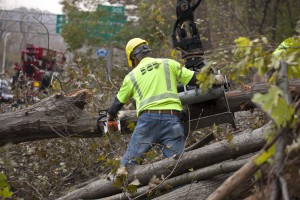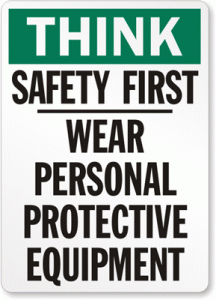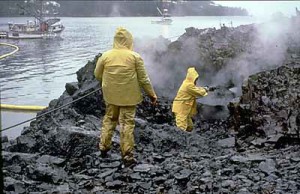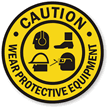Why is worker safety neglected in post-disaster cleanups?

Crews faced endless debris, and sometimes unsafe working conditions, after Superstorm Sandy. (Photo by New York City Department of Transportation, via Creative Commons.)
Following a natural or man-made disaster, time is of the essence for mitigating the damage. But does the need for a rapid response justify throwing worker safety out the window?
Standards from the Occupational Safety & Health Administration require that workers receive adequate protection against workplace hazards, including protective equipment and training.
But from the 9/11 attacks to Superstorm Sandy, some reports say lax regulations place post-disaster cleanup workers and volunteers in danger.
In the case of Superstorm Sandy, which devastated the Eastern seaboard last October, cleanup workers faced every imaginable health threat – working on roofs without fall protection, working in polluted water without protective equipment, and working around exposed, live wiring – that caused injuries and at least two deaths. According to an investigation by the Daily News, contractors handling cleanup and repair efforts following the massive hurricane shrugged off safety violations, and OSHA inspectors primarily issued warnings rather than citations.
This lackadaisical approach was also reported by some of the 47,000 workers and volunteers who descended on the Gulf of Mexico to help with the cleanup following the Deepwater Horizon oil spill in 2010. According to a report from the Government Accountability Project, a government watchdog group, they received little to no safety training or personal protective equipment. One worker was even cleared to help with the cleanup efforts while wearing “an apron, a hairnet, a spatula, and some rubber gloves,” the report says.

Messages that are made front-and-center at traditional work sites, through signs such as this often fall by the wayside post-disaster. (Image from MySafetySign.com.)
Many workers and local residents have come forward to report that they suffered health problems from exposure to the 1.8 million gallons of a chemical agent used to disperse the 210 million gallons of crude oil that poured into the Gulf of Mexico. Their symptoms ranged from skin lesions and blood in the urine to abdominal pain, heart palpitations, memory loss, nervous system and organ damage and temporary paralysis. While the chemical dispersant, Corexit, is approved by the EPA, it’s banned in the United Kingdom.
In addition, none of the workers received the federally required safety training – only 30,000 received a four-hour safety training course, despite an OSHA standard that requires 24-hour or 40-hour training courses for workers who may be exposed to high levels of hazardous chemicals.
What’s perhaps most alarming is that a similar scenario played out during cleanup efforts of the Exxon Valdez oil spill in 1989. According to the report, one chemical in Corexit, 2-butoxyethanol, was linked to health problems suffered by Exxon Valdez cleanup workers – who also received shortened training sessions, and was found at double the safe level in 20 percent of the Deepwater Horizon cleanup workers.

Many of the health hazards experienced by cleanup crews for the Exxon Valdez oil spill were repeated during the Deepwater Horizon cleanup. (Photo by NOAA, via Wikimedia Commons.)
So, will we ever learn? Maybe. While Corexit meets the EPA’s current requirements, the agency plans to revise the toxicity testing requirements for products that are authorized for use on oil discharges. And last September brought a small-but-somber victory and increased awareness of the price too often paid by first responders and cleanup crews. The National Institute for Occupational Safety announced 50 types of cancer would be covered under a federally funded health care program set up for survivors of the 9/11 terrorist attacks – who face a host of health effects and an increased cancer risk due to excessive exposure to carcinogenic dust and hazardous emissions.















